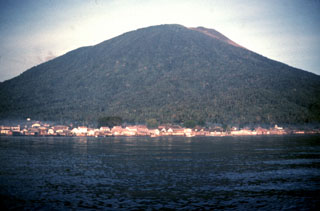Report on Gamalama (Indonesia) — February 1992
Bulletin of the Global Volcanism Network, vol. 17, no. 2 (February 1992)
Managing Editor: Lindsay McClelland.
Gamalama (Indonesia) Increased seismicity
Please cite this report as:
Global Volcanism Program, 1992. Report on Gamalama (Indonesia) (McClelland, L., ed.). Bulletin of the Global Volcanism Network, 17:2. Smithsonian Institution. https://doi.org/10.5479/si.GVP.BGVN199202-268060
Gamalama
Indonesia
0.81°N, 127.3322°E; summit elev. 1714 m
All times are local (unless otherwise noted)
A thin white vapor plume rose 50-100 m above the crater rim in early March, accompanied by an average of 26 volcanic earthquakes/day. Deep volcanic earthquakes increased from 91 during the first week in March to 159 the following week, as the weekly number of shallow volcanic earthquakes grew from 18 to 26.
Geological Summary. Gamalama is a near-conical stratovolcano that comprises the entire island of Ternate off the western coast of Halmahera, and is one of Indonesia's most active volcanoes. The island was a major regional center in the Portuguese and Dutch spice trade for several centuries, which contributed to the extensive documentation of activity. Three cones, progressively younger to the north, form the summit. Several maars and vents define a rift zone, parallel to the Halmahera island arc, that cuts the volcano; the S-flank Ngade maar formed after about 14,500–13,000 cal. BP (Faral et al., 2022). Eruptions, recorded frequently since the 16th century, typically originated from the summit craters, although flank eruptions have occurred in 1763, 1770, 1775, and 1962-63.
Information Contacts: W. Modjo and W. Tjetjep, VSI.

